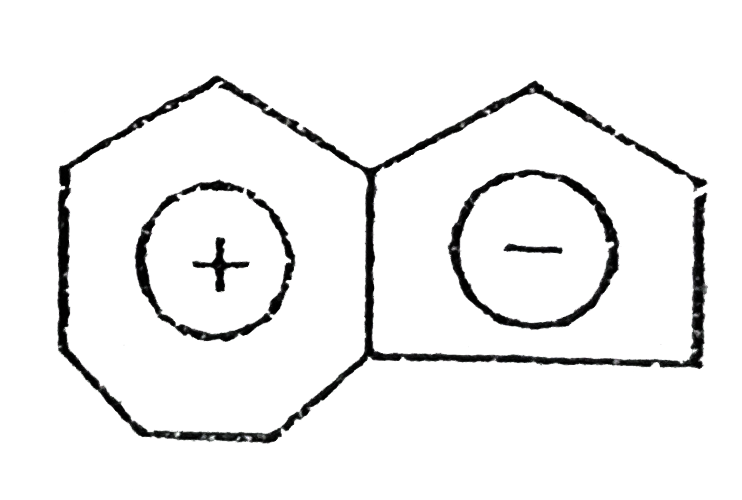Statement-1: CH3CH2⊕CH2 is less stable than CH3−N∣H−⊕CH2
and
Statement-2: Carbocation with adjacent hetero-atom like N O are less stable .
Statement -1 is True, Statement -2 is True, Statement -2 is a correct explanation for Statmenet -1.
Statement -1 is True, Statement -2 is True, Statement-2 is NOT a correct explanation for Statement -1
Statement -1 is True, Statement -2 is False
Statement -1 is False, Statmenet -2 is True
The correct Answer is:C
To solve the question, we need to analyze both statements provided and determine their validity.
Step 1: Analyze Statement 1
Statement 1 claims that the carbocation CH3CH2CH2+ is less stable than CH3N(CH2)+.
- Explanation:
- The carbocation CH3CH2CH2+ (which is a primary carbocation) has limited stabilization options. It can only stabilize itself through hyperconjugation, which involves the interaction of adjacent C-H sigma bonds with the empty p-orbital of the positively charged carbon. In this case, it has only two alpha hydrogens available for hyperconjugation.
- On the other hand, CH3N(CH2)+ has a nitrogen atom adjacent to the positively charged carbon. Nitrogen has a lone pair of electrons that can be donated to the carbocation through a +M (mesomeric) effect, which provides significant stabilization to the positive charge. This donation helps complete the octet for both nitrogen and the positively charged carbon, making this carbocation more stable.
Conclusion for Step 1:
Thus, Statement 1 is correct: CH3CH2CH2+ is indeed less stable than CH3N(CH2)+.
Step 2: Analyze Statement 2
Statement 2 claims that carbocations with adjacent heteroatoms like nitrogen or oxygen are less stable.
- Explanation:
- This statement is misleading. In fact, carbocations adjacent to heteroatoms (like nitrogen or oxygen) are generally more stable due to the ability of these heteroatoms to donate lone pairs of electrons.
- Nitrogen can donate one lone pair, while oxygen can donate two lone pairs, both of which can help stabilize the positive charge on the carbocation. Therefore, the presence of adjacent heteroatoms typically enhances the stability of carbocations rather than decreases it.
Conclusion for Step 2:
Thus, Statement 2 is incorrect: Carbocations with adjacent heteroatoms are more stable, not less stable.
Final Conclusion:
- Statement 1 is true.
- Statement 2 is false.
Answer:
The correct answer is that Statement 1 is true and Statement 2 is false.
---
Statement 1 claims that the carbocation CH3CH2CH2+ is less stable than CH3N(CH2)+.
- The carbocation CH3CH2CH2+ (which is a primary carbocation) has limited stabilization options. It can only stabilize itself through hyperconjugation, which involves the interaction of adjacent C-H sigma bonds with the empty p-orbital of the positively charged carbon. In this case, it has only two alpha hydrogens available for hyperconjugation.
- On the other hand, CH3N(CH2)+ has a nitrogen atom adjacent to the positively charged carbon. Nitrogen has a lone pair of electrons that can be donated to the carbocation through a +M (mesomeric) effect, which provides significant stabilization to the positive charge. This donation helps complete the octet for both nitrogen and the positively charged carbon, making this carbocation more stable.
Thus, Statement 1 is correct: CH3CH2CH2+ is indeed less stable than CH3N(CH2)+.
Statement 2 claims that carbocations with adjacent heteroatoms like nitrogen or oxygen are less stable.
- This statement is misleading. In fact, carbocations adjacent to heteroatoms (like nitrogen or oxygen) are generally more stable due to the ability of these heteroatoms to donate lone pairs of electrons.
- Nitrogen can donate one lone pair, while oxygen can donate two lone pairs, both of which can help stabilize the positive charge on the carbocation. Therefore, the presence of adjacent heteroatoms typically enhances the stability of carbocations rather than decreases it.
Thus, Statement 2 is incorrect: Carbocations with adjacent heteroatoms are more stable, not less stable.
- Statement 1 is true.
- Statement 2 is false.
The correct answer is that Statement 1 is true and Statement 2 is false.
Topper's Solved these Questions
- ORGANIC CHEMISTRY: SOME BASIC PRINCIPLE AND TECHNIQUESBook:AAKASH INSTITUTE ENGLISHChapter:ORGANIC CHEMISTRY: SOME BASIC PRINCIPLE AND TECHNIQUESExercise:SECTION-F MATRIX-MATCH TYPE QUESTIONS
Explore 4 Videos
- ORGANIC CHEMISTRY: SOME BASIC PRINCIPLE AND TECHNIQUESBook:AAKASH INSTITUTE ENGLISHChapter:ORGANIC CHEMISTRY: SOME BASIC PRINCIPLE AND TECHNIQUESExercise:SECTION-G INTEGER ANSWER TYPE QUESTIONS
Explore 8 Videos
- ORGANIC CHEMISTRY: SOME BASIC PRINCIPLE AND TECHNIQUESBook:AAKASH INSTITUTE ENGLISHChapter:ORGANIC CHEMISTRY: SOME BASIC PRINCIPLE AND TECHNIQUESExercise:SECTION-D LINKED COMPREHENSION TYPE QUESTIONS
Explore 7 Videos
- ORGANIC CHEMISTRY : SOME BASIC PRINCIPLES AND TECHNIQUES Book:AAKASH INSTITUTE ENGLISHChapter:ORGANIC CHEMISTRY : SOME BASIC PRINCIPLES AND TECHNIQUES Exercise:Assignment(Section-D)(Assertion - Reason Type Questions)
Explore 15 Videos
- POLYMERSBook:AAKASH INSTITUTE ENGLISHChapter:POLYMERSExercise:ASSIGNMENT (SECTION-D)
Explore 13 Videos
Similar Questions
Knowledge Check
The carbocation CH3+CHCH3 is less stable than
ACH3CH2+CH2B+CH2C(CH3)3+CDCH3+CH2CH3−CH2−O∣∣C−CH3∣C∣CH3−CH3PhCO3H−−−−−→A,A will be
ACH3−CH2−O−O∣∣C−CH3∣C∣∣CH3−CH3BCH3−CH2−O∣∣C−O−CH3∣C∣CH3−CH3CCH3−CH2−O∣∣C−CH3∣−∣CH3O−CH3DNone of these
Monomer of ⎡⎢ ⎢⎣−CH3∣C∣CH3−CH2−⎤⎥ ⎥⎦nis
View SolutionCH3−CH3∣CH−CH2−CH2C∣∣O−CH+3H2/Pd/C−−−−−−→ No. of stereoisomerism. Find the number.
View SolutionCH3−CH2−CH2−O−CH3 and CH3−CH3∣CH−O−CH3 are
View SolutionCH3−O∣∣C−CH2−CH3∣C∣CH3−CHOKOH,H2O−−−−−−→Δ product (C7H10O) :
View SolutionThe IUPAC name of following structure is
CH3−CH3∣CH−C∣∣O−CH2−CH2OH
View SolutionCH3−C∣CH3H−CH=CH2+H2OH+−−→X
What is X ? Suggest the mechanism.
View Solution

 is antiaromatic molecule
is antiaromatic molecule